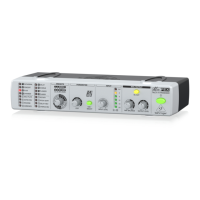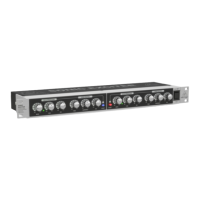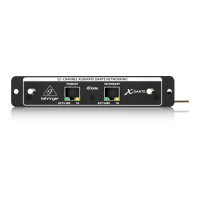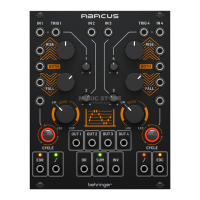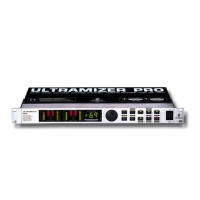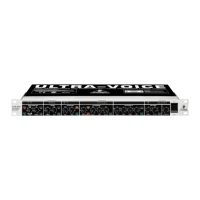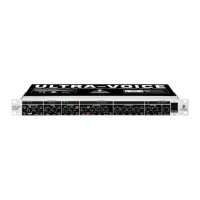15
MODULIZER PRO DSP1224P
The parameters:
VARIATION: Ratio: controls the ratio of input vs. output level for all signals surpassing the threshold. If
set to maximum, the DSP1224P works as a limiter.
EDITA: Threshold: adjusts the compressor threshold from -60dB to 0dB.
EDITB: Output gain: this parameter allows you to raise or lower the output signal in level by max.
24dB.
EDITC: Attack: the attack control determines the time the compressor needs to respond to signals
that are surpassing the threshold (5-200 ms).
EDITD: Release: controls the time the compressor needs to restore the original level, once the signal
has dropped below threshold (50-500 ms).
+ In all dynamics algorithms the mix function is disabled: because a compressor processes the
entire signal, any other operating mode would make no sense!
Expander
Many audio signals are limited in their dynamics by nature. For example, recordings made outdoors
usually suffer from a high level of background noise (traffic noise, wind, etc.). Guitar pick-ups, amplifiers,
etc. can produce high noise levels or other sounds that inevitably limit the dynamic range of the wanted
signal. Background noise of this kind is inaudible as long as the level of the processed signal is consid-
erably higher than the noise floor and hence masks the interference noise.
Expanders are used to effectively enlarge the dynamic range of signals by attenuating signals with small
amplitudes, which also reduces the background noise level.
The parameters:
VARIATION: Ratio: this parameter determines the ratio of input vs. output levels for all signals below
threshold.
EDITA: Threshold: adjusts the expander threshold within a range from -60dB to 0dB.
EDITB: Output Gain: allows for raising/lowering the output signal by max. 24dB.
EDITC: Attack: controls the time the expander needs to respond to signals that are below threshold
(5-200ms).
EDITD: Release: sets the time the expander needs to restore the original signal level (1:1) (50-500ms).
+ Similar to the compressor, there is no need for a mix function here.
Noise Gate
Noise gates can be used in a variety of applications, both on stage and for miking instruments in the
studio. For example, they can be used to suppress feedback (e.g. from vocal mics) or to fade out vocal
signals (plus background noise) during pauses. In this case, the gate must reopen very quickly, so that
subdued syllables can be heard. Noise gates are often used to record or mix drum sets, so as to avoid
possible crosstalk-induced phase problems.
The parameters:
VARIATION: Threshold: determines the threshold below which the gate cuts off the signal.
EDITA: Hold: sets how long signals below threshold can still pass the gate, to allow for a smooth
control process (1-1,000 ms).
EDITB: Range: determines the degree of attenuation when the gate is closed. If set to maximum, the
signal is faded out completely.
EDITC: Attack: sets how fast the gate opens when the signal has surpassed the threshold (1-100ms).
EDITD: Release: determines how fast the gate closes after the hold time has expired (1-800 ms). The
release time depends on the signal envelope, percussive sounds (short decay) need much quicker
release times than, for instance, sustained keyboard pads.
+ No mix function.
1. INTRODUCTION
